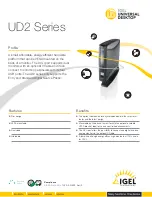
-3-
airspeed; hence airspeed related functions are disabled. The JETCat version is compatible only
with JETCat engines.
It is not possible to upgrade a BASIC unit to a PLUS unit after manufacture.
Currently the available accessories are:
GPS module
LED indicators.
Pitot probe. (Only for PLUS version).
Electric connections
All the connections are placed on the left side of the box
and functions labeled. (Picture 1)
From Left to Right:
Throttle Out1, Out2, In:
Twin engine operation. Not used
on current release.
Telemetry Out:
Data output to receiver.
GPS:
Connection to GPS Module
Eng1:
Connection to ECU. Xicoy ecus with servo lead data
terminal currently supported.
Eng2:
Connection to second engine. Not supported in
current release.
LED:
Output to 2 external LED lights.
Port1…6:
Not used. Inputs/Outputs for future expansion (sequencer, etc)
If telemetry is used, the unit will be powered from the telemetry lead from the RX.
If telemetry is not used, then the unit can be powered directly from the ecu, if the ecu is of latest
version (year 2012 or newer), but the ecu will power only the flight computer. If external
modules like GPS are installed, it is necessary to provide external power. Connect the patch
cable provided from the “throttle In” socket to any unused socket on the receiver or PowerBox-
like system. Signal present on this output is not important, only power will be used 9 Volt
maximum.
Warning:
All sockets, except the Engine 1 and 2, are connected in parallel. In an installation that
uses different voltages, a cross connection can occur through the device. For example, if the RX
is powered at 5.0V by an independent source but any other input is connected to a different
higher voltage, then the RX will be powered to this higher voltage trough the telemetry lead. In
this case, it is necessary to cut the red wire on the telemetry lead to avoid feeding the RX trough
this lead.
Air pressure input:
(PLUS model only)
Connect the lines from the Pitot tube on the
nipples on the bottom of the box. Top nipple is
the static input (white) and bottom is the
dynamic pressure input (red).
Picture 1
Picture 2


























